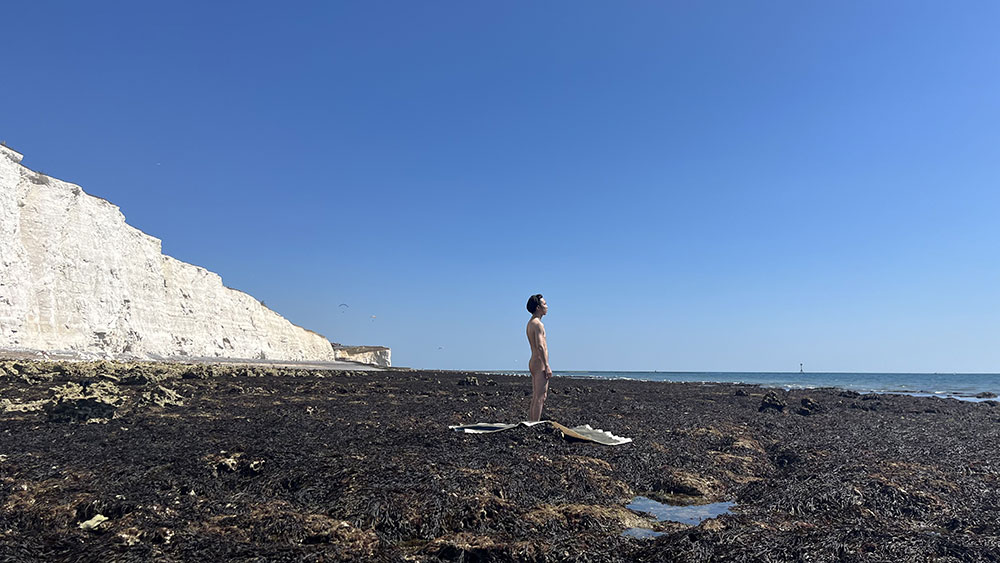The only way to gain a thorough understanding of the world is to join history.
London, United Kingdom
@ginowowng902 | www.ginowoart.com
INTERVIEW
In your education, you’ve traversed a path of studying art and design, installation, and printmaking. How does this knowledge base assist you now?
During my undergraduate studies, I engaged with foundational concepts in media studies, which I consider pivotal to my current creative endeavors. Frequently, I find myself grounding my work in the materiality of media, thereby establishing a foundational legitimacy. In agreement with Marshall McLuhan’s assertion that ‘Media is the message,’ I contend that the pervasive influence of media largely shapes our perception of the world. Therefore, the media studies I previously undertook enable my work to adopt a broader, more universally resonant perspective.

Tell us how you chose the theme for your artistic endeavors and why you decided to delve into the concept of duality and the interaction between humans and nature, and their lives in the modern world, where standards are imposed by the internet and mass media.
My fascination with media, like social and video-sharing platforms, led to a realization: virtual mediums, notably the internet, often eclipse our corporeal selves in daily life, as seen in films like ‘The Matrix’ and ‘The Truman Show.’ This prompts concern about corporeal displacement, influenced by algorithmic determinism. My creative pursuits aim to restore corporeal presence, acknowledging its political, cultural, and societal significance. Despite historical subjugation, particularly in Western thought, and the dominance of empirical science, the corporeal realm remains vital. I advocate privileging nuanced, phenomenological understanding over reductionist epistemologies. This entails recognizing the dialectic between rationality and sensuality, corporeal and ethereal, natural and industrial, and virtual and tangible. In scholarly pursuit, I emphasize the corporeal vessel as a fundamental locus of inquiry and intervention.

Your art is often presented in the form of installations or performances, and you actively incorporate yourself. How do you choose the media you work with and how do you conceptualize your projects?
In my quest to restore corporeal presence in our daily lives, I prioritize emphasizing the embodiment of artistic mediums in my work. I argue that conventional two-dimensional mediums have contributed to the marginalization of bodily presence, especially with the advent of Gutenberg’s printing press. While this innovation facilitated the spread of Protestant ideology and spurred the Enlightenment, it also abstracted human experience.
Conversely, three-dimensional mediums offer spatial qualities that encourage viewer interaction and performer engagement. By fostering reciprocal exchanges between participants and artworks or performers, I aim to heighten awareness of bodily presence and perceptual embodiment. This emphasis on reciprocity underscores the transformative potential of corporeal engagement in artistic expression.

Xuanjun, you are a person of two cultures. How were your works perceived in Asia and Europe, and was it necessary to adapt the same project to different geographical contexts?
The intersectionality of identity, cultural perception, and artistic expression is evident in my experiences, notably through a comment from a Chinese friend during my UK degree show. Their observation on the bravery of nudity in a Western context underscores cultural norms’ role in artistic choices. Having migrated to the UK at a young age and completing studies there, I’ve gained insights into diverse traditions and societal norms.
Despite varied cultural backgrounds, global issues like right-wing politics and economic disparities transcend borders. The internet accelerates information dissemination, enabling global access to news and opinions.
In international exhibitions, engaging with diverse audiences fosters dialogue and feedback. Constructive criticism aids artistic growth, yet those uninterested in my work are less likely to critique. Thus, fostering open dialogue and seeking diverse perspectives enriches artistic discourse and promotes cross-cultural understanding.

To date, you have international experience participating in exhibitions and fairs. How has participation in these events shaped you as an artist?
As I became increasingly involved in exhibitions, I found that it didn’t significantly contribute to the advancement of my artistic practice. Instead, I became more aware of the fact that in the contemporary art market, both artists and their artworks need to be symbolized and capitalized upon to gain a foothold. I don’t believe any individual artist possesses the capacity to resist this structure. Consequently, I’ve come to realize that I can only to a certain extent utilize this reality to support and augment my own creative endeavors..

What advice would you give to aspiring artists?
The contemporary landscape of art education increasingly prioritizes commercial viability, aligning academic distinction with market trends. This has fostered conformity among art students, who may prioritize adherence to prevailing styles to meet evaluative criteria.
However, amidst this commercialization, some artists eschew market-driven trends for authentic, introspective practice. Opting for self-directed exploration over external accolades, they affirm the value of artistic integrity.
I believe art serves as a conduit for genuine self-exploration, free from external validation. This commitment extends to engagement with lived experiences and societal concerns.
I think that art’s essence lies in evoking introspection and empathy in viewers, fostering understanding. Through personal embodiment in their work, they invite audiences to reflect on their own experiences.